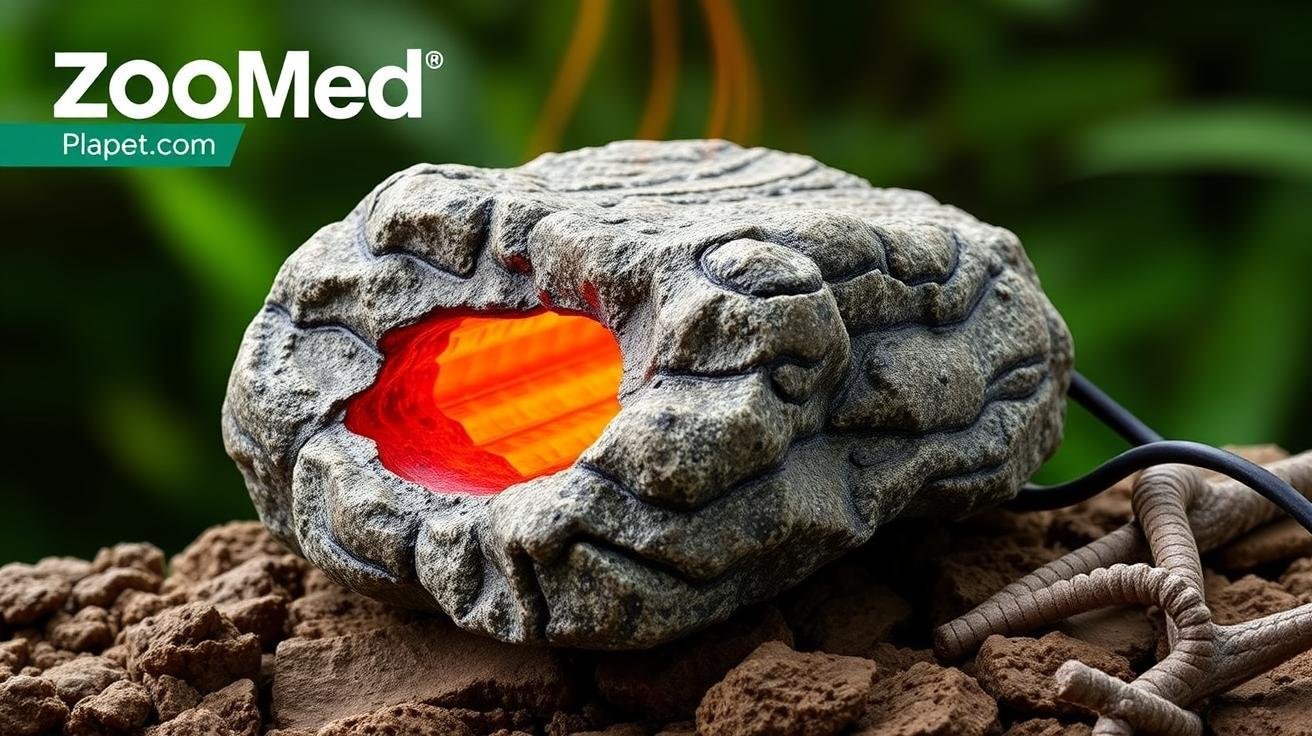Zoo Med Rock Heater Review: An Expert’s Verdict

Estimated Reading Time: 8 minutes
Key Takeaways: Zoo Med Repticare Rock Heater Review
- Targeted Heat: Provides essential belly heat that is crucial for the digestion and thermoregulation of many ground-dwelling reptile species.
- Energy Savings: An extremely energy efficient, using only 8 watts design means it costs very little to run 24/7, making it an economical choice for long-term use.
- Safety First: The UL listed for safety certification and a fully encapsulated heating element for even heat distribution provide peace of mind for reptile keepers.
- Low Maintenance: Features an easy-to-clean, washable resin surface that simplifies terrarium hygiene and maintenance routines.
- Naturalistic Design: The rock-like appearance blends seamlessly into most desert or woodland terrarium setups, enhancing the aesthetic while providing a functional heat source.
Table of Contents
- An Expert’s Look at a Terrarium Classic
- The Final Say: Is It Worth It?
- Who Is This Product Best For?
- Core Advantages of the Repticare Rock Heater
- High Points and Points to Consider
- Rock Heater vs. Under-Tank Heaters
- Care & Maintenance Tips
- Frequently Asked Questions
- Closing Notes
An Expert’s Look at a Terrarium Classic
As a seasoned reptile enthusiast and professional reviewer, I’ve seen countless heating products come and go. Yet, some staples remain for a reason. Providing the correct thermal gradient is arguably the most critical aspect of reptile husbandry. Reptiles are ectothermic, meaning they rely on external sources to regulate their body temperature. Without proper heat, they can’t digest food, their immune systems weaken, and their overall health declines. While overhead lamps are great for ambient and basking heat, many species benefit immensely from ‘belly heat’—a direct, gentle warmth from below that mimics a sun-warmed rock.
This is where the Zoo Med Repticare Rock Heater – Standard Size comes into play. For decades, Zoo Med has been a trusted name in reptile care, and their rock heater is one of the most recognizable products on the market. But does this classic piece of equipment still hold up against modern alternatives? In this in-depth review, we’re going to dive deep into this specific terrarium heat source for reptiles. We’ll analyze its features, discuss who it’s best for, and provide the honest, expert opinion you need to decide if it’s the right choice for your scaly companion’s home.
- Heated “safety Stone”
- For Indoor use only
- Manufacturer: ZOO MED LABORATORIES INC
- No synthetic resin
The Final Say: Is It Worth It?
Let’s cut to the chase. For the right reptile and the right setup, the Zoo Med Repticare Rock Heater is an excellent, reliable, and affordable secondary heat source. Its primary strength lies in its ability to deliver consistent, direct belly heat, which is a game-changer for digestion in species like leopard geckos or young bearded dragons. The unit is incredibly simple to set up and use, and its energy efficient, using only 8 watts, design is a major plus for any keeper’s electricity bill. The safety features, particularly being UL listed for safety and having a fully encapsulated heating element, offer significant peace of mind. While it should never be the sole heat source in a terrarium, when paired with a quality thermostat and appropriate overhead lighting, it becomes a powerful tool for creating a perfect thermal environment.
Who Is This Product Best For?
Understanding the target audience for this heater is crucial. It’s not a one-size-fits-all solution. This product is ideal for:
- Leopard Gecko Keepers: These geckos are famous for absorbing heat through their bellies. A regulated rock heater on the warm side of their tank can be a perfect way to aid digestion after a meal.
- Beginner Reptile Owners: The plug-and-play nature of the Repticare Rock Heater makes it incredibly user-friendly for those new to the hobby. Its simplicity removes a lot of the guesswork associated with more complex heating systems.
- Owners of Small to Medium Desert Terrariums: The standard size is well-suited for 10 to 20-gallon tanks. It provides a dedicated warm spot without overheating the entire enclosure.
- Keepers on a Budget: Not only is the initial purchase price affordable, but its low wattage makes the long-term running cost almost negligible. This makes it a very accessible piece of essential gear.
However, it’s less suitable for large reptiles that could cover the entire rock, burrowing species that might dig underneath it, or high-humidity tropical setups where standing water could be an issue. Always research your specific animal’s needs first.
Core Advantages of the Repticare Rock Heater
The longevity of the Zoo Med Repticare Rock Heater isn’t an accident. It’s built on a foundation of simple yet effective features that directly address the needs of captive reptiles.
Fully Encapsulated Heating Element for Even Heat Distribution: This is perhaps the most important safety and performance feature. The heating element is completely sealed within the non-porous resin. This design prevents dangerous hot spots from forming on the surface, ensuring a consistent and gentle warmth across the entire rock. It also protects the element from any moisture, which is a critical safety consideration inside a terrarium.
Promotes Healthy Digestion for Reptiles: As mentioned, ectotherms require warmth to metabolize their food. By providing a direct source of belly heat, this heater allows a reptile to rest on the surface after eating and efficiently digest its meal. This process is crucial for nutrient absorption and preventing serious health issues like impaction. The steady warmth mimics the natural behavior of basking on sun-warmed earth or rocks.
Energy Efficient, Using Only 8 Watts: In an era of rising energy costs, this is a standout benefit. The standard model consumes a mere 8 watts of power. To put that in perspective, it’s less than most modern LED light bulbs. You can leave this heater running 24/7 as part of your thermal gradient without ever worrying about a surprise on your electricity bill. This efficiency makes it a sustainable choice for long-term reptile care.
Easy-to-Clean, Washable Resin Surface: Hygiene is paramount in reptile enclosures to prevent bacterial and fungal growth. The Zoo Med Repticare Rock Heater is made from a durable, non-porous resin. This means waste, spilled water, or food doesn’t seep into the material. A simple wipe-down with a reptile-safe disinfectant is all it takes to keep it clean, making it a far more hygienic option than natural rocks, which can be difficult to sanitize thoroughly.
UL Listed for Safety: This certification is a non-negotiable for many experienced keepers. Underwriters Laboratories (UL) is a third-party organization that tests products for safety against fire and electrical shock. A UL listing means the heater has met rigorous safety standards, providing invaluable peace of mind when you have a heating element running inside your pet’s home around the clock.
High Points and Points to Consider
High Points
- Extremely durable construction.
- Naturalistic look enhances terrarium decor.
- Provides vital belly heat for digestion.
- Very low power consumption.
- Simple plug-and-play operation.
Points to Consider
- Must be used with a thermostat for safety.
- Not a primary or sole heat source.
- Can get too hot if covered by deep substrate.
- The standard size may be too small for larger reptiles.
Rock Heater vs. Under-Tank Heaters
A common alternative for providing belly heat is an under-tank heater (UTH) or heat mat. How does the Zoo Med Repticare Rock Heater stack up? Both have their place in reptile husbandry, and the best choice often depends on your specific setup.
| Feature | Repticare Rock Heater | Under-Tank Heater (UTH) |
|---|---|---|
| Placement | Inside the terrarium, can be moved easily. | Sticks to the outside bottom of the tank. |
| Aesthetics | Acts as a decorative, functional piece of cage furniture. | Completely hidden from view. |
| Heat Transfer | Direct contact with the animal. Heat is very localized. | Heats through glass/plastic and a thin layer of substrate. |
| Substrate Compatibility | Works best on top of a thin layer of substrate or a bare floor. | Not effective with deep substrate that insulates the heat. |
| Ease of Cleaning | The rock itself needs to be cleaned regularly. | The heater itself stays clean; only the substrate above it needs cleaning. |
The main advantage of the rock heater is its dual function as decor and its direct, focused heat. A UTH provides a more diffuse warm area. For reptiles that like to bask on a specific spot, the rock is often preferred. However, for shy or burrowing species, a UTH might provide a more subtle and secure warm area underneath the substrate.
Care & Maintenance Tips
To ensure the longevity and safety of your Zoo Med Repticare Rock Heater, a little routine care goes a long way. First and foremost, always unplug the heater before cleaning. Use a reptile-safe disinfectant and a soft cloth or paper towel to wipe down the entire surface. Thanks to its easy-to-clean, washable resin surface, this is a quick and simple task. Avoid using abrasive sponges or harsh chemicals that could damage the resin.
Periodically, check the power cord for any signs of fraying, chewing, or damage, especially at the point where it enters the rock. While durable, it’s always good practice to inspect any electrical device in your pet’s enclosure. Finally, ensure the rock is placed on a level surface and is not buried under a deep layer of substrate, which could cause heat to build up and potentially damage the unit or create an unsafe temperature.
Frequently Asked Questions
1. Is it safe to leave the Zoo Med Repticare Rock Heater on all the time?
Yes, it is designed for continuous operation. However, it is critically important to connect it to a quality thermostat. A thermostat will cycle the power on and off to maintain a safe, consistent temperature and prevent any chance of overheating, which is essential for your reptile’s safety.
2. Can I use this rock heater for my snake?
This is generally not recommended. Many species of snakes, particularly those that coil, have been known to suffer thermal burns from older models of heat rocks because they don’t always move away when it gets too warm. For snakes, an under-tank heater or overhead ceramic heat emitter controlled by a thermostat is a much safer option.
3. How do I know what temperature the rock is?
You should never rely on feel alone. Use a digital temperature gun (infrared thermometer) to get an accurate surface reading of the rock. This allows you to adjust your thermostat precisely to achieve the perfect temperature for your specific pet, typically in the 88-92°F range for a species like a leopard gecko.
Closing Notes
The Zoo Med Repticare Rock Heater – Standard Size has earned its place as a staple in the reptile hobby for good reason. It’s a simple, effective, and safe way to provide the crucial belly heat that many reptiles need to thrive. Its combination of an energy efficient design, a fully encapsulated heating element for even heat distribution, and an easy-to-clean, washable resin surface makes it a practical and reliable choice. When used correctly—as a secondary heat source connected to a thermostat—it is an invaluable tool for creating a healthy and comfortable environment for your pet.
If you’re looking to enhance your terrarium’s thermal gradient and specifically support your reptile’s digestive health, this is a product that delivers on its promises without breaking the bank. It’s a testament to good design that stands the test of time.




